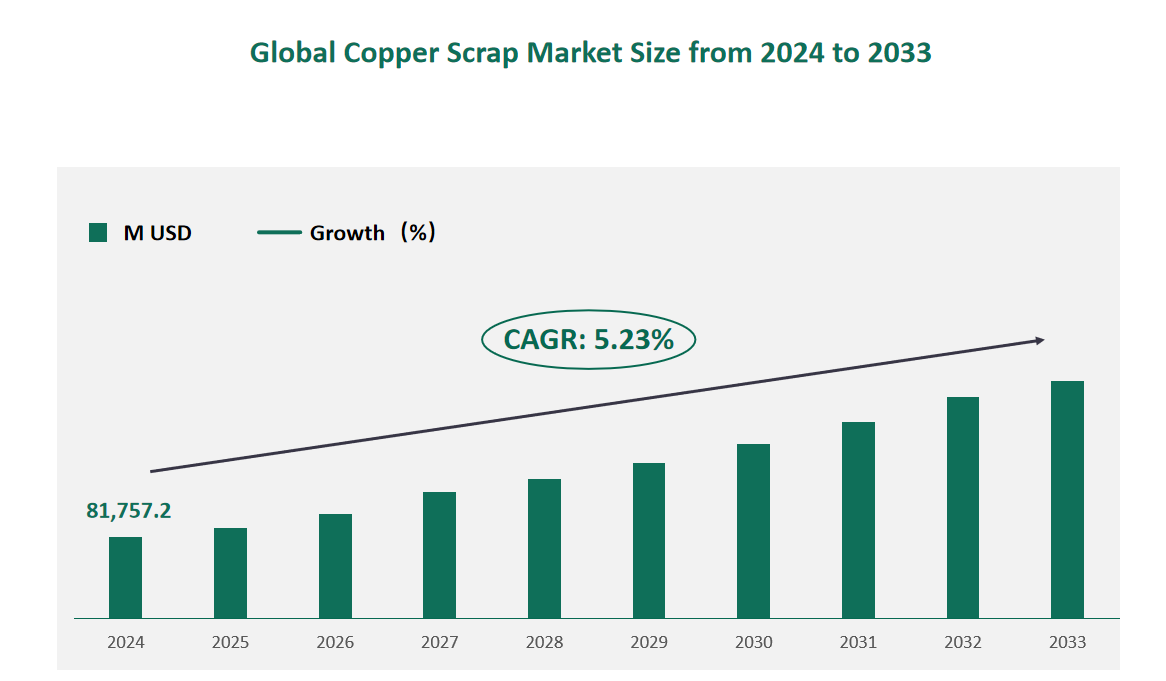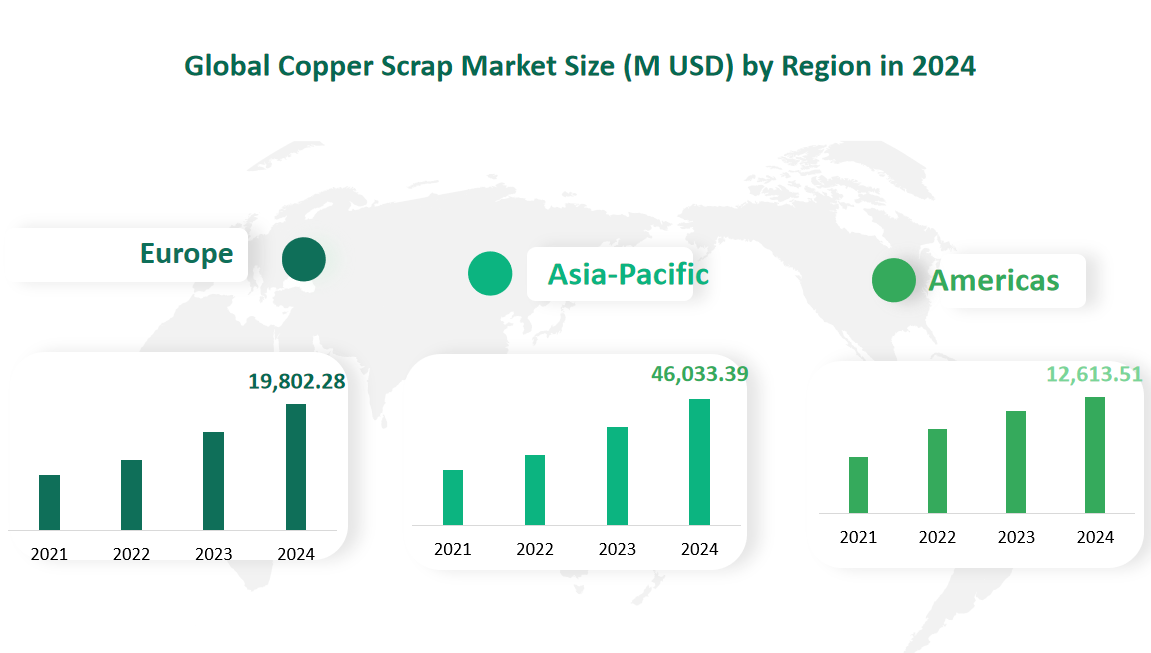1 Global Copper Scrap Market Size (Value) and CAGR (2024-2033)
In 2024, the global Copper Scrap market was valued at USD 81,757.2 million, with a CAGR of 5.23% from 2024 to 2033.
Copper scrap refers to all kinds of discarded copper materials produced in the process of production, processing and use, and its main sources include the waste generated in the process of copper industrial production, including scraps, mechanical processing crumbs, etc., which can be directly used for copper smelting; Or scrap copper disassembled from waste transformers, motors, cables, household appliances, etc., mostly exists in the form of copper alloys.
Figure Global Copper Scrap Market Size (M USD) and CAGR 2024-2033

2 Copper Scrap Market Drivers
One of the primary drivers of the copper scrap market is the significant economic and environmental benefits associated with recycling copper. Recycling copper requires up to 90% less energy compared to primary production, resulting in substantial cost savings and reduced carbon dioxide emissions. According to the U.S. Geological Survey, copper recycling can mitigate up to 0.2-0.3% of global greenhouse gas emissions. Additionally, recycling copper scrap helps conserve natural resources by reducing the need for virgin copper mining, which is both resource-intensive and environmentally damaging. The circular economy model, particularly prominent in Europe, further emphasizes the importance of recycling copper scrap to achieve sustainability goals.
The increasing demand for copper in multiple end-use sectors is another critical driver of the copper scrap market. Copper is a versatile material with excellent electrical and thermal conductivity, making it indispensable in industries such as electronics, transportation, construction, and industrial machinery. For instance, the automotive sector, especially with the rise of electric vehicles (EVs), requires a significant amount of copper for electrical components, wiring, and batteries.
Electric vehicles use up to four times more copper than conventional internal combustion engine vehicles, driving the need for recycled copper to meet this demand sustainably. Similarly, the construction industry relies heavily on copper for plumbing, roofing, electrical wiring, and heating systems. The global construction boom, particularly in developing countries, further fuels the demand for copper scrap as a cost-effective and sustainable alternative to virgin copper.
Advancements in recycling technologies have significantly enhanced the efficiency and effectiveness of copper scrap processing. Modern techniques, such as laser object detection and automated sorting systems, enable recyclers to process complex copper waste more efficiently, reducing costs and improving recovery rates. For example, companies like Kuusakoski Oy and Tomra Systems have developed innovative methods to extract copper from electronic waste and other complex materials. These technological advancements not only improve the economic viability of copper scrap recycling but also contribute to higher environmental standards by minimizing waste and maximizing resource utilization.
3 Copper Scrap Market Challenges
One of the primary challenges facing the copper scrap market is the environmental impact associated with the recycling process. Copper recycling involves the generation of wastewater and other pollutants, which can pose significant environmental risks if not managed properly. The increasing regulatory scrutiny on environmental protection has led to higher compliance costs for recyclers.
The copper scrap recycling industry exhibits significant regional disparities in terms of infrastructure, technology, and market maturity. Developed regions like Europe and North America have well-established recycling systems with advanced technologies and robust regulatory frameworks. In contrast, emerging and developing countries often lack the necessary infrastructure and technology to efficiently process complex copper waste.
The increasing complexity of copper-containing products, particularly in the electronics and automotive sectors, poses a significant challenge for recyclers. Modern electronic devices and vehicles contain a multitude of components with varying copper content and alloy compositions, making the separation and extraction of copper more difficult and costly.
4 Global Copper Scrap Market Size by Type in 2024
No. 1 (>98% Cu Content) Grade
This grade of copper scrap is characterized by its high purity, containing more than 98% copper content. It is often referred to as “clean” copper scrap and includes materials such as new unused copper, heavy melting copper, and clean copper tubing. No. 1 grade copper scrap is highly valued due to its superior quality and is often used directly in copper smelting or manufacturing processes without the need for further refining. In 2024, the market value of No. 1 grade copper scrap was $41,443.55 million, accounting for a significant portion of the total market.
No. 2 (94%-96% Cu Content) Grade
No. 2 grade copper scrap has a slightly lower copper content, ranging between 94% and 96%. This type includes materials like insulated copper wire, copper-bearing scrap, and mixed copper scrap. While it requires some processing to remove impurities, No. 2 grade copper scrap is still highly valuable and is commonly used in applications where high purity is not as critical. In 2024, the market value of No. 2 grade copper scrap was $21,669.81 million.
Table Global Copper Scrap Market Size by Type in 2024
Type | Market Size (M USD) 2024 |
No. 1 (>98% Cu Content) Grade | 41443.55 |
No. 2 (94%-96% Cu Content) Grade | 21669.81 |
Others | 18643.83 |
5 Global Copper Scrap Market Size by Application in 2024
The electronics industry is a major consumer of copper scrap, utilizing it in the production of printed circuit boards, connectors, and other components. In 2024, the market value for copper scrap in electronics was $34,115.76 million. This segment is driven by the rapid growth in consumer electronics, the increasing demand for electric vehicles, and the need for sustainable materials in manufacturing processes. Copper’s high conductivity and recyclability make it an ideal material for this sector, contributing to the circular economy.
The transportation sector, including automotive, aerospace, and rail industries, is another significant user of copper scrap. In 2024, the market value for copper scrap in transportation was $9,893.77 million. Copper is used in radiators, brake systems, electrical wiring, and other components due to its thermal conductivity and durability. The increasing demand for electric vehicles, which require more copper than conventional vehicles, has further boosted this segment.
Copper scrap is widely used in the construction industry for plumbing, roofing, electrical wiring, and heating systems. In 2024, the market value for copper scrap in construction was $17,031.65 million. Copper’s corrosion resistance and durability make it a preferred material for long-lasting infrastructure projects. The global construction boom, particularly in developing countries, has driven the demand for copper scrap in this sector.
The industrial machinery and equipment sector uses copper scrap in the production of motors, transformers, and other electrical components. In 2024, the market value for copper scrap in this application was $13,348.12 million. Copper’s high electrical conductivity and thermal conductivity make it essential for efficient energy transfer and heat dissipation in industrial applications.
Table Global Copper Scrap Market Size by Application in 2024
Application | Market Size (M USD) 2024 |
Electronics | 34115.76 |
Transport | 9893.77 |
Construction | 17031.65 |
Industrial machinery and equipment | 13348.12 |
Others | 7367.90 |
6 Global Copper Scrap Market Size by Region in 2024
The Asia-Pacific region is the largest market for copper scrap, valued at $46,033.39 million in 2024. This region’s dominance is driven by rapid industrialization and urbanization, particularly in China and India. The region’s strong manufacturing base, particularly in electronics and automotive industries, fuels the demand for copper scrap. China, the world’s largest copper consumer, plays a pivotal role in driving regional demand. The region’s recycling infrastructure is also improving, supported by government initiatives to promote sustainable practices.
Europe is the second-largest market for copper scrap, valued at $19,802.28 million in 2024. The region’s strong emphasis on the circular economy and sustainable practices has led to advanced recycling infrastructure and high recycling rates. European countries, particularly Germany and the UK, are leaders in copper scrap recycling, driven by stringent environmental regulations and a focus on reducing carbon emissions. The region’s automotive and construction industries are significant consumers of copper scrap.
The Americas, including the United States, Canada, and Mexico, accounted for a market value of $12,613.51 million in 2024. The region’s market is driven by the automotive and construction industries, particularly in the United States. The U.S. is a major producer and consumer of copper scrap, supported by a well-developed recycling infrastructure. The region’s market is also influenced by trade policies and economic conditions.
Figure Global Copper Scrap Market Size by Region in 2024

7 Major Players in Global Copper Scrap Market
7.1 Aurubis
Company Profile:
Aurubis AG is a global leader in non-ferrous metals and one of the world’s largest copper recyclers. Established in 1886, the company operates primarily in Europe and the USA, with a significant presence in Asia. Aurubis processes a wide range of metal concentrates, scrap, and recycling materials into high-quality metals. The company’s manufacturing bases are distributed across Europe and the USA, with sales regions extending globally.
Business Overview:
Aurubis is renowned for its advanced recycling technologies and sustainable practices. The company processes various types of copper scrap, including high-purity No. 1 grade and No. 2 grade materials. Their recycling operations start with precise chemical analysis and extend to state-of-the-art pyrometallurgical and hydrometallurgical processes, ensuring high-quality output. Aurubis’s commitment to environmental sustainability and resource efficiency has positioned it as a leader in the circular economy.
Copper Scrap Operations and Financial Performance:
In the most recent year, Aurubis reported a sales volume of 553.6 thousand tons of copper scrap. The company’s revenue from copper scrap operations reached $4,509.68 million, with a gross margin of 22.29%.
7.2 European Metal Recycling (EMR)
Company Profile:
European Metal Recycling (EMR) is a leading European recycling company with operations in the UK, Germany, the Netherlands, and the USA. Established in 1950, EMR aims to become a leader in sustainable materials. The company works with a diverse range of industries, including automotive, demolition, construction, and electronics, to recycle metal waste into valuable resources.
Business Overview:
EMR specializes in processing and trading non-ferrous metal scrap, including copper. The company offers a wide range of high-quality products, such as copper granules, copper cuts, and mixed electric motors. EMR’s recycling operations involve advanced separation and processing techniques, ensuring efficient recovery of valuable metals. The company’s commitment to sustainability and innovation has positioned it as a key player in the global copper scrap market.
Copper Scrap Operations and Financial Performance:
In the most recent year, EMR reported a sales volume of 251.8 thousand tons of copper scrap. The company’s revenue from copper scrap operations reached $2,098.21 million, with a gross margin of 20.95%.
7.3 Chiho Environmental Group
Company Profile:
Chiho Environmental Group is one of the largest publicly listed global scrap metal recycling companies, with extensive operations in China, India, Malaysia, Thailand, and Europe. Established in 1995, the company specializes in recycling ferrous and non-ferrous metals, end-of-life vehicles, electronic waste, and secondary aluminum ingots. Chiho’s geographical presence includes over 200 processing plants and yard operations across Asia, Europe, and North America.
Business Overview:
Chiho Environmental Group is known for its advanced recycling technologies and comprehensive recycling operations. The company processes various types of copper scrap, including mixed metal scrap from motors and electrical wires. Chiho’s state-of-the-art processing technologies enable efficient separation and recovery of valuable metals, including copper. The company’s commitment to sustainability and resource efficiency has positioned it as a leader in the global recycling industry.
Copper Scrap Operations and Financial Performance:
In the most recent year, Chiho Environmental Group reported a sales volume of 54.0 thousand tons of copper scrap. The company’s revenue from copper scrap operations reached $398.96 million, with a gross margin of 20.76%.

